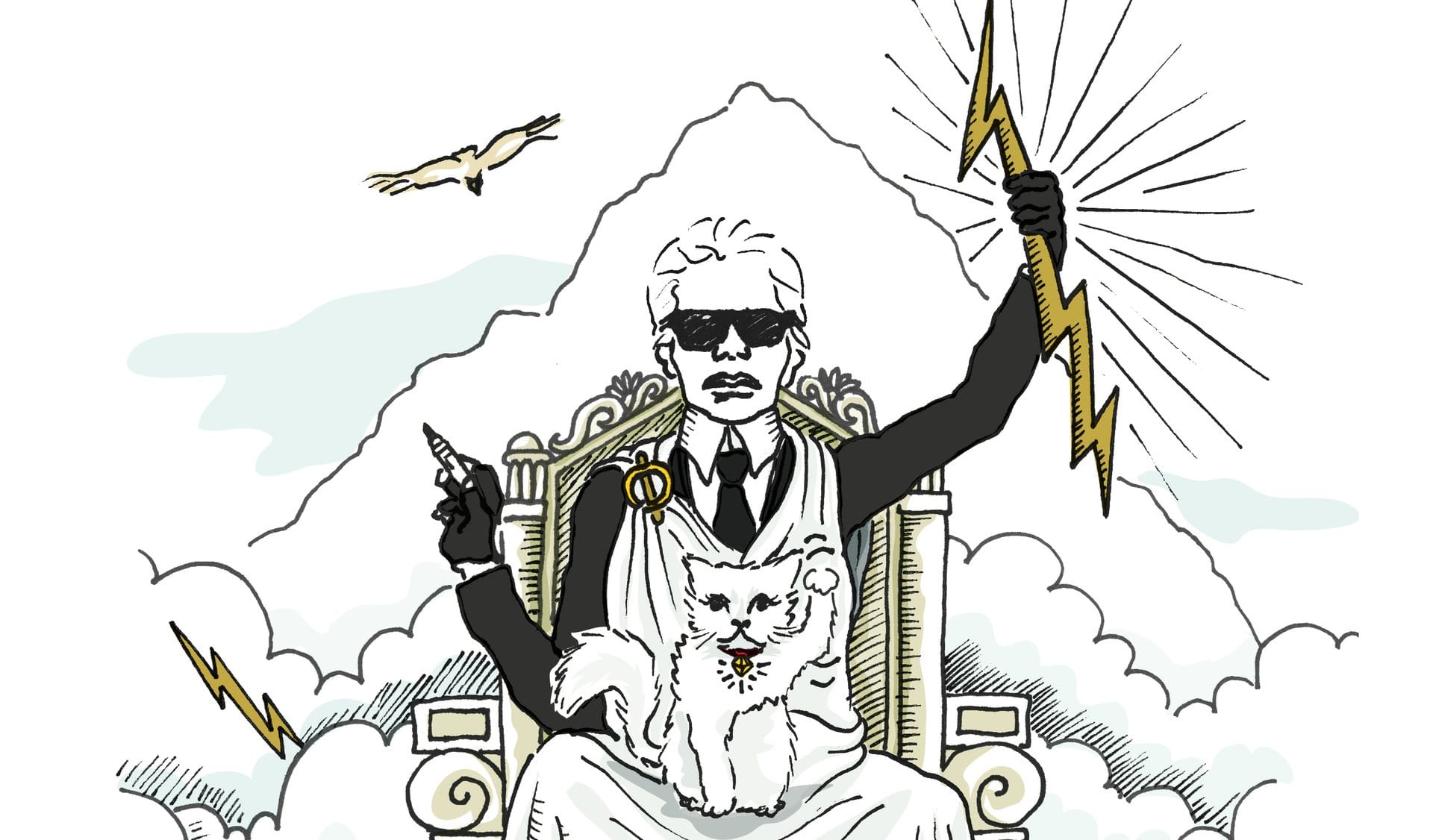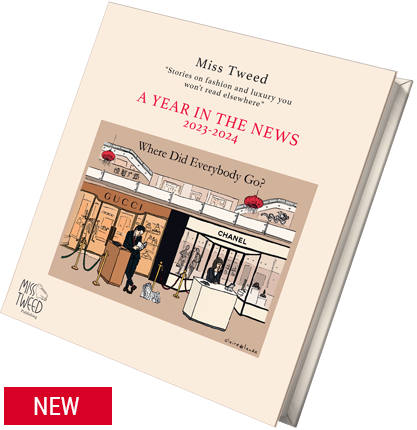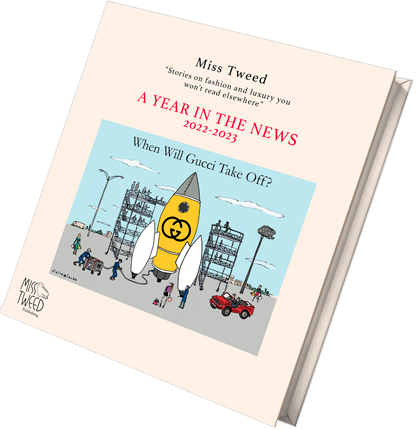The man who understood everything about luxury was Karl Lagerfeld. Before he died on February 19th 2019, Lagerfeld was the last of the great couturiers still at work. For most people, the more they age, the less they want to work. For Lagerfeld, it was the opposite. Toward the end of his life, he was running out of time. He still had so much to say and so many things to create, so every year his output increased. By 2018, he was designing seventeen collections a year, of which 10 were for Chanel and the rest for Fendi and his own eponymous brand. Karl was one of the last, if not the last couturier who drew everything himself. Another species on the verge of extinction.
His fashion shows had become jaw-dropping, breathtaking events. Karl asked for the impossible and got it. “Anyway, if someone tells me it is too expensive, then I answer that I do not work for poor people,” Lagerfeld told me in a long interview. At his fashion shows in the vast Grand Palais in the heart of Paris, Lagerfeld transported us into fantasy worlds ranging from the Chanel cruise ship and Chanel space rocket to the North Sea island of Sylt, complete with vista, white sand and lapping waves. He never stopped raising the bar in terms of strong impressions. In the luxury world, there was Karl and the rest. His shows put pressure on rivals such as Louis Vuitton, Gucci and Dior to up their ante and stage fashion extravaganzas just as spectacular as his.
Chanel was able to surprise without changing designers. Other brands, which did not have Karl’s equivalent at hand, constantly had to hire new blood to awe buyers and the media. “You know, if you change designer every three days, it is difficult. Me, I guess I am a little bit more consistent. I do nothing vis-à-vis others,” Lagerfeld told me. “But there are times when I find myself nul (lame), lazy, sometimes I even have to pay back my client because it is so disgusting what I have just done… I do not have a discourse on ready-to-wear. I am less dramatic. I have done this job all my life. It preoccupies me, it stimulates me and worries me. I do not have a very intellectual discourse. Sometimes, when you listen to designers talk about their collection, I have no idea where they saw that. Their inspiration, where do they take it from? It is all in the mind, right?” he adds with a touch of irony.
The Hamburg-born designer spent some thirty-six years at Chanel and in parallel, more than half a century at Fendi. Prior to Chanel, he honed his skills at Chloé, and before that at Jean Patou and Pierre Balmain. He turned Fendi into a respected fashion house by reinventing its use of fur and bringing a touch of humor and impertinence to its classic Roman style.
Karl Lagerfeld built Chanel into the world’s second largest luxury brand in terms of sales behind Louis Vuitton. He also designed for his eponymous brand founded in 1984, which he described in the last years of his life as a sort of caricature of himself.
Commercially, the Karl Lagerfeld maison has been through its ups and downs and has never enjoyed the success of Chanel and Fendi. One day, a fortune-teller told him: “For you, it starts when it ends for others,” he recalled. “I have left a few people along on the road. I did what had to be done at that moment, me, I saw further ahead,” he said.
Nobody really knew Lagerfeld’s age. His brand’s website says he was born in 1938 but other sources cite 1933 and 1935. When he died, people said he was 85 but how can one be so sure? Karl Lagerfeld would have never been Karl Lagerfeld if one knew everything about him. The mystery around his age was part of the myth. In 2018, the couturier surprised the fashion world by appearing publicly with a beard, which, with hindsight, aptly cloaked his age and illness, in complement of his Michael Jackson-style leather gloves and high collars.
But his beard actually made him look like a modern Zeus. Karl Lagerfeld was the spiritual leader of the fashion crowd. He captured better than anybody else the spirit of the day and the moods of tomorrow. He chose the theme of each collection, wowing the audience every time. He drew and took photos with ease. He seemed to make no mistakes -- or at least nobody remembered him doing it.
Karl’s eye saw everything. Like Zeus, Karl Lagerfeld watched over his progeny - his colleagues and friends. People worked alongside him for decades, a sign they were well-looked after and enjoyed the challenge. “One doesn’t leave Chanel, one dies at Chanel,” people often said about the fashion house. Caroline Lebar, his head of communications and member of his first circle, worked with him for more than 30 years. […]
On a cold November evening in 2017, I found refuge in Lagerfeld’s warm office for an interview. His workplace was hidden behind the 7L bookstore in the 7th arrondissement in Paris, not far from Serge Gainsbourg’s house on rue de Verneuil. The 7L bookstore is sober, calm and elegant, with a quality selection of design and coffee-table books. It’s a place where you want to buy almost everything, from the Finnish black-and-white bird album to a gigantic encyclopedia of textiles. A few years ago, I was browsing books here alongside Diego Della Valle, chairman and controlling shareholder of Tod’s, who regularly visited the place. Lagerfeld had often said about collecting books: “It is a disease for which there exists no remedy.”
Next to the cashier, a thick metal and opaque glass door stood firmly closed. The world of Karl Lagerfeld was hidden behind and there was no point pushing it without being invited. The managers of the bookstore followed strict rules. They would not provide any information about Lagerfeld or the bookstore. I stayed there for about an hour before being allowed to pass through the mysterious door, giving me ample time to enjoy Karl’s bookstore, the best waiting room in the world.
The long-awaited moment finally arrives and I enter what looks like a dining room. It is a white open space with bar-height tables and chairs. Fresh salads, fruits and cheese assortments are displayed. Each plate is accompanied by a little white card that describes its content, out of consideration for those with allergies or intolerances. A cook in a white toque agitates his hands behind his kitchen’s pass-through. A waltz of orders comes from various assistants and models. A stout man, bald and tattooed, walks up to him and says: “It will only be the scallops for me thanks.” People speak French, English or Italian and eat dinner together without really dining together. This is not a restaurant but a refueling station. People take what they need and leave.
I had often heard that Karl worked only under the best conditions. Now I understand better what that meant. Three towering graces wearing flower wreaths and rose pastel tweed costumes float through the dining room, laughing out loud. They are getting ready to seduce the camera by exchanging jokes. A voice shouts: “Karl, we are ready for the photo when you are!”
I follow the models’ footsteps and enter a room as big as a gymnasium, its walls covered from top to bottom with books. I have never seen so many books in one single room in my entire my life. Surely, there are enough to open several bookstores. I think about all those that closed on Boulevard Saint Germain in Paris such as La Hune, which was known for its well-endowed philosophy section, or the Geography Bookstore. They’ve been replaced by Louis Vuitton and Poiray jewelers respectively. Maybe their books found shelter here? Lagerfeld’s library is not only an incredible monument to bibliophilia. In my imagination, it is a Noah’s Ark for all the books chased away by luxury boutiques in the Latin Quarter.
A spiral staircase serves as the mast of the boat, linking up to a balcony with a balustrade that gives access to those books situated at higher levels. On the floor, long taupe grey sofas invite you to sit and enjoy the collection. Like Zeus, Lagerfeld speaks nearly every language, well almost every language. He reads English, French, German, Italian, Spanish and Latin. He is unbeatable in art history, northern European literature, design, photography and philosophy. In a corner of this gigantic library, a creamy white background paper several meters long lies unfolded like a tongue. That is where Lagerfeld takes his photos. Projectors and spotlights of all sizes await their prey. I am told I need to leave. Strangers are not allowed to stay while Karl works.
A few minutes later, the master accepts to see me in an adjacent room. I find him sitting at a table under a large white parasol that emanates a strange blue light. Lagerfeld wears a grey jacket over his traditional white shirt with a high starched collar and a black silk tie, on which is pinned a silver motif of his Burmese cat Choupette. Around his neck are long necklaces of pearls in various shades of grey. They match his silver leather gloves cut half-way. As he greets me, he takes off his sunglasses. The gesture takes me by surprise. Karl Lagerfeld never shows his eyes. He is over 80 but I find his gaze young, fresh and alert. His eyes mirror the vivacity of his mind. They also express a genuine kindness which perhaps is something he sought to hide behind his shades for fear it could be interpreted as some kind of weakness. […]
Kaiser Karl says what he thinks, which no-one does anymore in our ultra-controlled and paranoid world. For the couturier, political correctness was the ultimate expression of boredom. One must avoid at all costs all these all these Gutmenschen who keep talking about all the good things they do. Karl attacked the limits placed on freedom of speech. “Now, you are still responsible for what you said 40 years ago. Everything is forbidden! Back in the days (in 1968), it was forbidden to forbid. And we are surprised by the rise of populists! It is because they actually say something.”
Lagerfeld flees normality. He will do anything to stand out and be different, which is why the world of luxury and fashion suits him so well. He is in his element. Lagerfeld is endowed with a natural class, an innate sense of artistic harmony. A true esthete, he goes so far as to ban words from his vocabulary. “I hate the word unisex! Everybody has arms and legs. And for the rest – that can be arranged!” he adds tongue-in-cheek.
Chanel gave Karl free rein for many decades but the maison started getting a little nervous about what the old couturier could say publicly in the last few years before his death. In 2018, Lagerfeld barely gave any interviews after his shows. In May that year, he sparked controversy – yet again – by threatening to give up his German citizenship. He declared that he did not want to be a member of this “club of neo-Nazis” that let extreme rightists become members of parliament. He blamed Chancellor Angela Merkel’s lax immigration policy -- she suddenly let in large waves of Middle Easterners fleeing war and oppression in the summer of 2015 -- for Germany’s subsequent turn toward the right wing. […]
Karl Lagerfeld hated conformism and strived to never give a banal answer. To the rather banal question of what made him happy, the designer had told me: “That is a much too ambitious question I do not ask myself. You know I am in a very good position. I have life-long contracts with Fendi and Chanel, I do what I want, when I want, where I want. It is very reassuring. Actually, firing me would cost more money than keeping me, so… And I do not have an oversized ego. I am easy to work with.” Having done his job for such a long time, he knew exactly what worked and what did not. When he was younger, he admitted, he had an oversized ego. After a certain age -- we will never know when – he said he became humbler.
One of the key elements of success in luxury, tested and approved by Karl Lagerfeld, is the perpetual renewal of the same idea. Since his arrival at Chanel in 1983, the designer always stayed true to Gabrielle Chanel’s sensibility and universe while giving it a contemporary twist. Striking the right balance between heritage and relevance is a form of art. For Yves Saint Laurent, fashion is “not really an art but it needs an artist to exist.” […]
For Lagerfeld, nothing was impossible. He always aimed high. Everything had to meet his own norms, which were beyond anyone else’s norms. “Karl says that we must do unimaginable things,” said Hubert Barrère, a professional corset-maker and creative director of Maison Lesage, a specialist embroiderer that belongs to Chanel.
Lagerfeld always refused to write his memoirs or take part in retrospectives about his life or his work. He published many books of photos and drawings with German publisher Steidl and released a best-seller dedicated to his cat Choupette, a Burmese with clear blue eyes.
Lagerfeld was only interested in the present and in what would happen tomorrow. “You know I am not very good at delving into my past,” he told me. “Especially not my own past. I am in the here and now. I know others’ stories better than my own. Mine - I never think about them. When you start talking about the good old days, I leave. Quelle horreur!”















